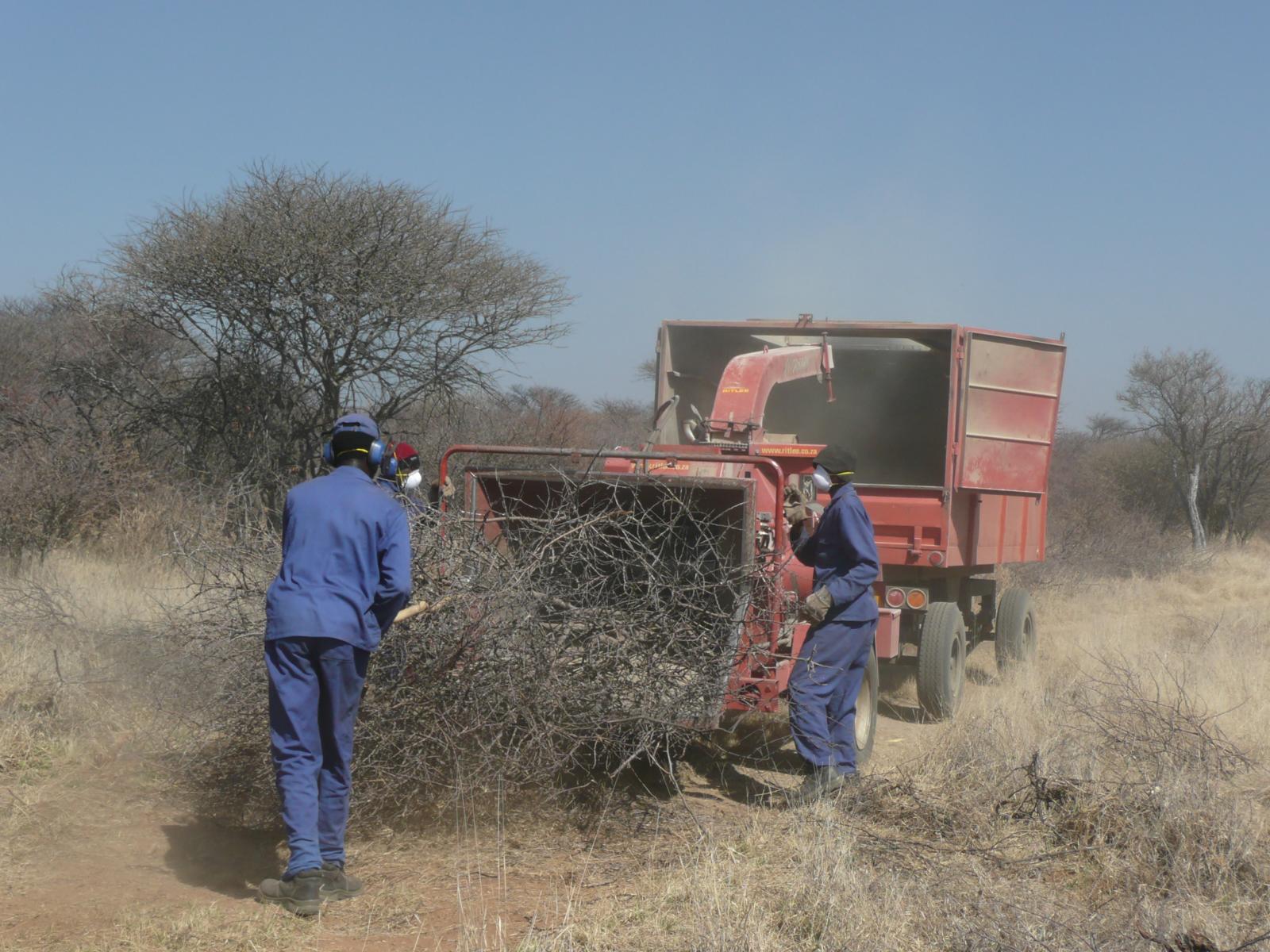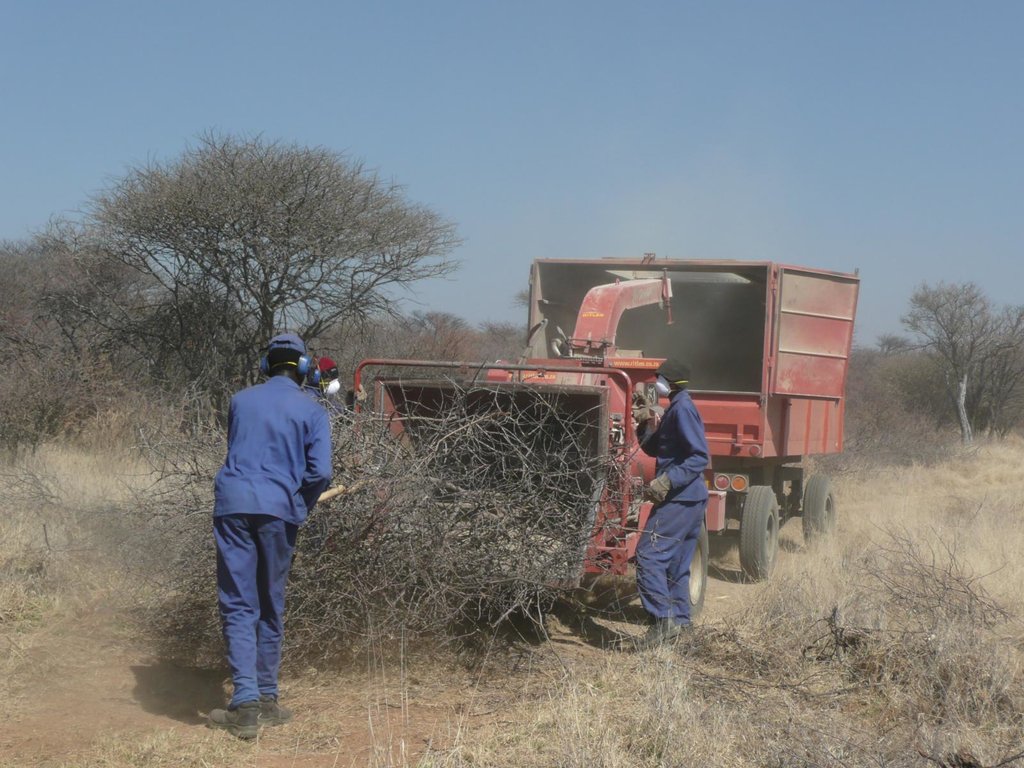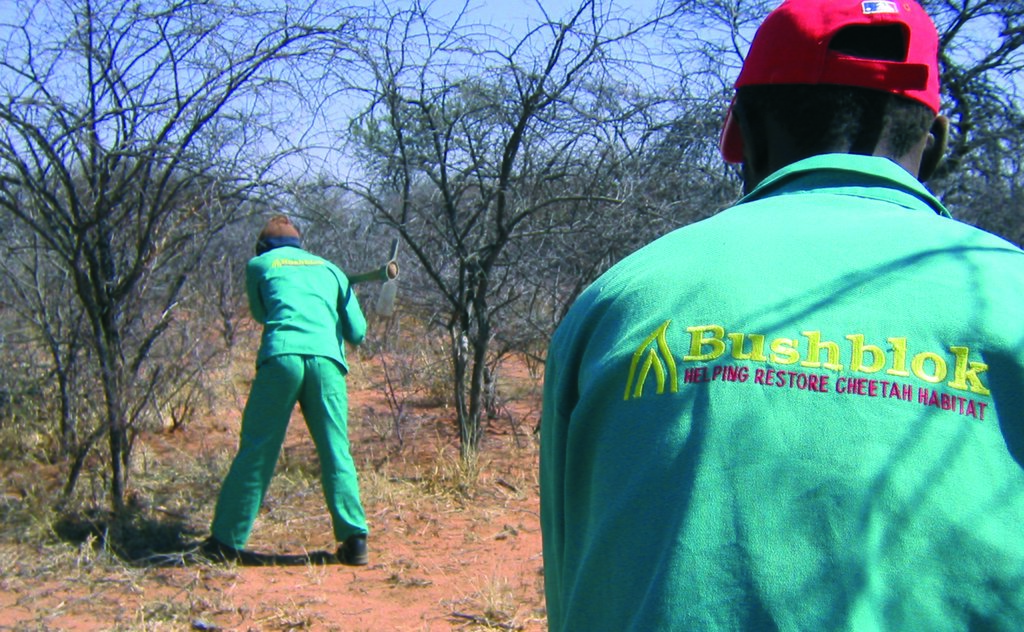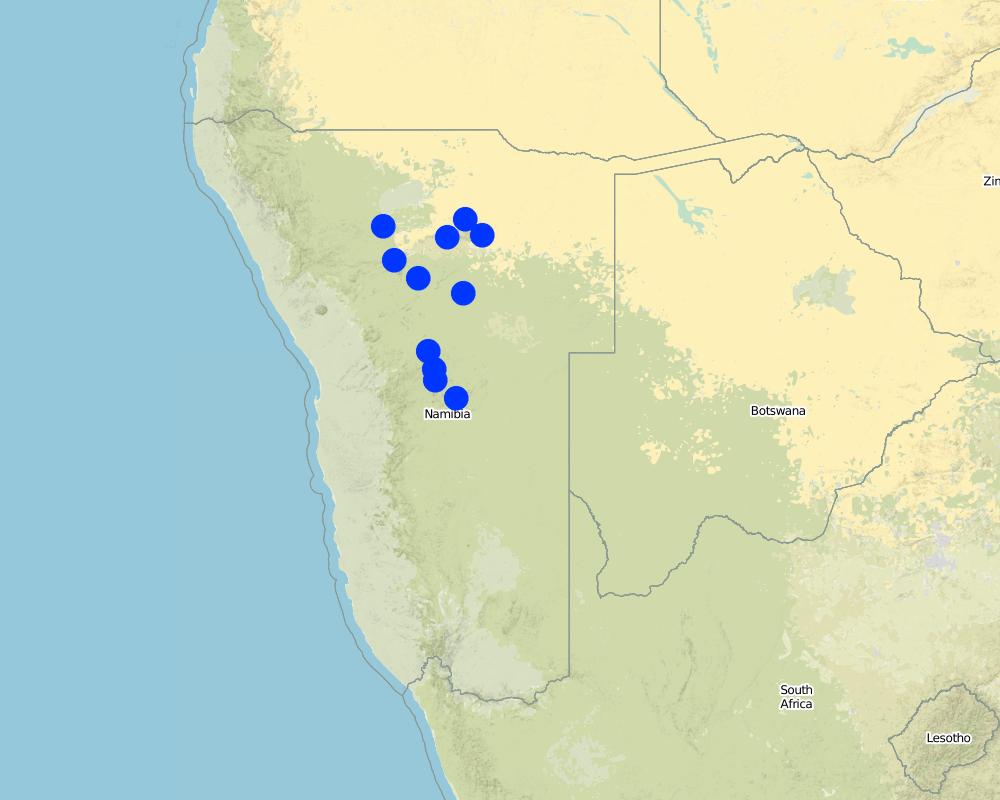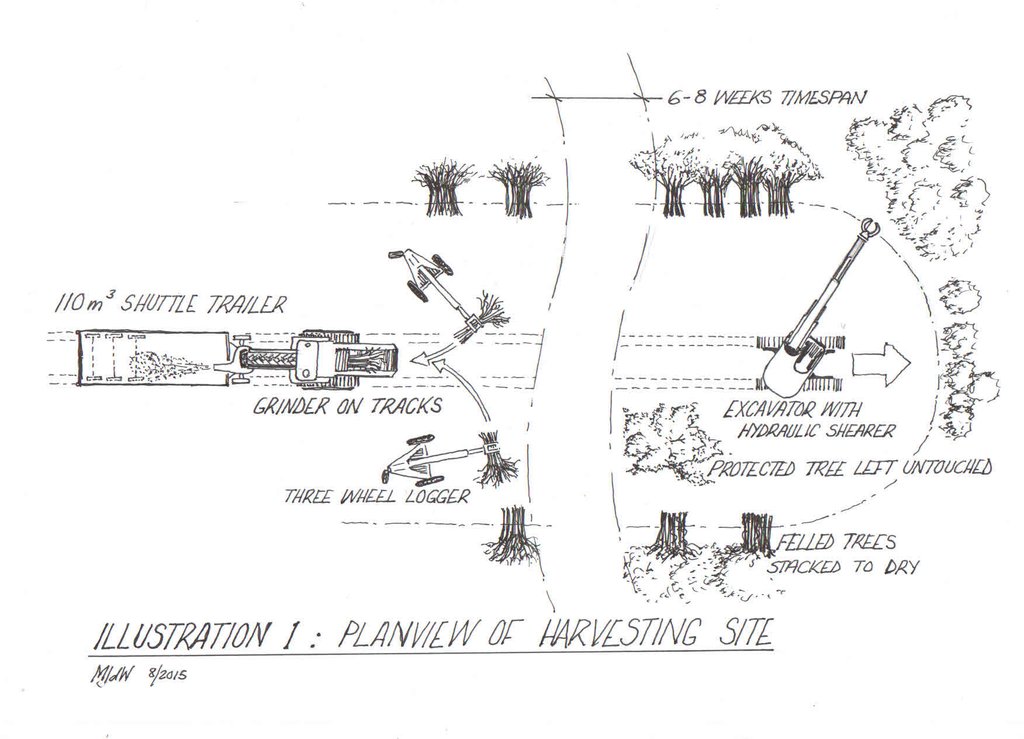Bush Thinning and Biomass Processing by Manual or Mechanised Means [ناميبيا]
- تاريخ الإنشاء:
- تحديث:
- جامع المعلومات: Johannes Laufs
- المحرر: –
- المُراجع: Rima Mekdaschi Studer
De-bushing
technologies_2203 - ناميبيا
- Bush Thinning and Biomass Processing by Manual or Mechanised Means: 17 يوليو، 2018 (inactive)
- Bush Thinning and Biomass Processing by Manual or Mechanised Means: 31 مايو، 2019 (inactive)
- Bush Thinning and Biomass Processing by Manual or Mechanised Means: 22 أغسطس، 2017 (inactive)
- Bush Thinning and Biomass Processing by Manual or Mechanised Means: 2 نوفمبر، 2021 (public)
- Bush Thinning and Biomass Processing by Manual or Mechanised Means: 21 فبراير، 2018 (inactive)
عرض الأقسام
توسيع الكل طي الكل1. معلومات عامة
1.2 تفاصيل الاتصال بالأشخاص الرئيسيين لمصدر المعلومات والمؤسسات المشاركة في تقييم وتوثيق التقنية
اسم المؤسسة (المؤسسات) التي سهلت توثيق/تقييم التقنية (إذا كان ذلك على صلة)
Deutsche Gesellschaft für Internationale Zusammenarbeit (GIZ) GmbH (GIZ) - ألمانيا1.3 الشروط المتعلقة باستخدام البيانات الموثقة من خلال WOCAT
متى تم تجميع البيانات (ميدانيا)؟:
01/08/2014
يوافق جامع المعلومات والشخص (لاشخاص) الرئيسي لمصدر المعلومات على الشروط المتعلقة باستخدام البيانات الموثقة من خلال WOCAT:
نعم
1.4 إعلان بشأن استدامة التقنية الموصوفة
هل التقنية الموصوفة هنا تمثل مشكلة فيما يتعلق بتدهور الأراضي، بحيث لا يمكن إعلانها تقنية مستدامة لإدارة الأراضي؟:
كلا
التعليقات:
The technology described is a means to rehabilitate degraded rangeland. Through targeted harvesting of bushes, the bush density is reduced, allowing for better growth of grass.
1.5 الإشارة إلى الاستبيان (الاستبيانات) حول مناهج الإدارة المستدامة للأراضي
2. وصف تقنيةالإدارة المستدامي للأراضي
2.1 وصف مختصر للتقنية
تعريف التقنية:
On Namibian farmland bushes are harvested in order to reduce the excessive bush densities, that stiffle the growth of other plant species, especially grasses. Bush can be harvested manually (e.g. with axes), semi-mechanised (e.g. chainsaws) or fully mechanised (e.g. customised excavators). After cutting, the bush is typically left to dry and in a second step processed into a transportable format (e.g. wood chips).
2.2 وصف تفصيلي للتقنية
الوصف:
Bush thinning in the form of selective bush harvesting is applied on Namibian agricultural land. The main aim of the technology is the restoration of degraded rangeland, reducing bush densities, fostering the re-growth of grasses. According to the best available estimates about 45 million hectares of Namibian farmland are affected by bush encroachment. Bush encroachment negatively affects biodiversity, groundwater recharge and importantly the carrying capacity of rangeland. Bush encroachment equally hinders crop production, but this phenomenon is of less significance in Namibia due to the limited scope of crop production in the country. There is a multitude of causes for bush encroachment, among which overgrazing (i.e. overstocking with cattle or lack of rotational grazing), reduced frequency of wildfires and higher CO2 concentrations in the atmosphere feature strongly. Bush encroachment is not to be equated with the invations of alien species, since most encroacher species are indigeneous to Namibia
While it is believed that natural transitions in the ecosystems can on the long-run, under favourable climatic conditions, also lead to reductions of bush encroachment, active rehablitation measures are required in order to achieve improvements on the short-run. This is an aboslute necessity for many Namibian farmers, who experience severe economic difficulties due to the reduced productivity of their land.
Bush control comprises of responsive measures (bush thinning), follow-up measures (aftercare) as well as preventative measures (good rangeland management practices). Since vast areas of Namibian rangeland are heavily encroached by indigenous bush species, the focus is currently on responsive measures, i.e. bush thinning.
Bush thinning entails the practice of selectively harvesting a specified number of bushes, effectively reducing the number of bushes per given area. To determine the density of bush remaining after thinning, a formula based on tree equivalent (TE) and average annual rainfall is used. A tree equivalent is defined as a woody tree or bush of 1,5 metres in height. Thus, a 3 metre shrub would represent 2 TE, a 4.5 metre shrub 3 TE. As rule of thumb for estimating optimal bush density, about 30-35% of encroacher biomass should be removed. This rule is based on research that has been carried out mainly in South Africa over the past decades, measuring and comparing the re-growth experienced at various sites where bush had been harvested. Areas, in which too much bush was removed, experienced strong re-growth of bush, often resulting in even heavier bush encroachment.
Bush thinning follows strict environmental guidelines set by the Ministry of Environment and Tourism through the Environmental Management Act with regard to the equipment's used (avoiding negative side-effects such as disturbance of the soil) and the amount of bushes to be harvested (aiming at the right balance between reducing the encroachment and maintaining a healthy number of the desired bush species). The amount of bushes to be harvested must be determined by expert for each specific area and depends on various factors, e.g. soil type, topgraphy, severity of bush encroachment and intended land use type.
It is important to note, that as with most direct interventions in natural ecosystems, there is a lack of precise knowledge on the long-term effect of bush thinning and the appropriate intensity thereof. There is however no doubt that active bush control has an overall positive effect on the savanna ecosystem in Namibia.
In order to render bush thinning economically feasible, value chains have been developed. Through the processing and utilisation of the woody bush biomass, income can be generated and the cost of bush conrol balanced. Existing value chains include the production of charcoal, firewood, poles, bush based animal feed as well as heat and electricity. Value chains currently under development include composition materials, such as wood-plastic, wood-cement and bio-plastic.
Scientific observations have shown, that bush thinning cannot be implemented as a once-off activity, but requires regular follow-up to prevent the re-thickening of the bush. Follow-up measures (so-called aftercare) include the prevention of coppicing and re-growth. This can be achieved by applying aboricides selectively to the cut stems, stem fires or the introduction of browsers (e.g. goats). Research on the effectiveness and possible side effects of each of these methods is limited.
The need for bush control, and therewith bush thinning, is widely recognised among land owners and also acknowledged on the national political agenda.
A major challenge for the implementation of the technology is the limited suitability of available machines. The hardness and high mineral content of the woody biomass leads to high wear and tear on the equipment (both harvesting equipment and processing equipment, like chippers and pelletisers), often rendering operations unprofitable. Research into more suitable machinery is ongoing.
Further, the implementation of sustainable bush control must be improved through skills training and continuous monitoring of the long-term effects on rangeland.
2.3 صور التقنية
ملاحظات عامة بخصوص الصور:
All photos have either been taken by the GIZ Support to De-bushing Project or were provided to the project by third parties.
2.4 فيديوهات عن التقنية
تعليقات، وصف موجز:
https://www.youtube.com/watch?v=859GshR9hso&t=3s
Bush Encroachment in Namibia: Causes and Extent
An explanation of the root causes of bush encroachment and its impact on land in Namibia.
التاريخ:
01/11/2015
الموقع:
Namibia
اسم مصور الفيديو:
GIZ Support to De-bushing Project
تعليقات، وصف موجز:
https://www.youtube.com/watch?v=bmlzPDiqlxo&t=45s
Biomass Value Addition: Bush Based Products
An overview of existing and potential value chains based on encroacher bush.
التاريخ:
01/11/2015
الموقع:
Namibia
اسم مصور الفيديو:
GIZ Support to De-bushing Project
تعليقات، وصف موجز:
https://www.youtube.com/watch?v=MMSOfV2KBjA
Biomass Energy: From Bush to Electricity
Overview of the energetic applications of woody biomass from encroacher bush.
التاريخ:
01/11/2015
الموقع:
Namibia
اسم مصور الفيديو:
GIZ Support to De-bushing Project
2.5 البلد/المنطقة/المواقع التي تم تنفيذ التقنية فيها والتي يغطيها هذا التقييم
البلد:
ناميبيا
مزيد من التفاصيل حول الموقع:
Bush control is applied across Namibia on many privately owned farms. Activities are most concentrated in the regions Khomas, Omaheke, Otjozondjupa and Oshikoto.
التعليقات:
Pointers on the map only indicate points (e.g. urban centres) around which activities are concentrated. It is not possible to depict each site where bush control is implemented due to the high number of individual activities and projects.
Map
×2.6 تاريخ التنفيذ
اذكر سنة التنفيذ:
2015
2.7 إدخال التقنية
حدد كيف تم إدخال التقنية:
- من خلال ابتكار مستخدمي الأراضي
- أثناء التجارب/الأبحاث
- من خلال المشاريع/ التدخلات الخارجية
التعليقات (نوع المشروع، الخ):
Since the 1950s the phenomenon of bush encroachment has been recognised by farmers in Namibia and counter measures have been implemented over the decades. The technologies applied largely relied on the means and innovative capabilities of the respective land owner. Only as of 2014, through the introduciton of a national Support to De-bushing Project, are technologies systematically researched and tested in the field.
3. تصنيف تقنية الإدارة المستدامي للأراضي
3.1 الغرض الرئيسي ( الأغراض الرئيسية) للتقنية
- تحسين الإنتاج
- الحد من تدهور الأراضي ومنعه وعكسه
- الحفاظ على النظام البيئي
- الحفاظ على/تحسين التنوع البيولوجي
- خلق أثر اقتصادي مفيد
3.2 نوع (أنواع) استخدام الأراضي الحالية حيث يتم تطبيق التقنية

أراضي الرعي
أراضي الرعي الواسع النطاق:
- مربى ماشية محدد
الأنواع والمنتجات الحيوانية الرئيسية:
Cattle, goats, game
التعليقات:
Namibia is characterised by large commercial cattle farms. Du to its aridity the land is largely unsuitable for crop farming, with exceptions in high-rainfall areas such as the Grootfontein, Tsumeb, Otavi triangle.
The Northern parts of Namibia are managed as communal land, where farmers have lease holds for their land. In these areas a combination of millet production and cattle herding is common.
إذا تغير استخدام الأراضي بسبب التقنية، قم بالإشارة إلى استخدام الأرض قبل تنفيذ التقنية:
The implementation of bush thinning allows to maintain the land use (e.g. cattle ranching) and is typically applied to increase productivity in the long-term.
3.3 مزيد من المعلومات حول استخدام الأراضي
إمدادات المياه للأرض التي يتم تنفيذ التقنية عليها:
- بعلية
عدد مواسم الزراعة في السنة:
- 1
كثافة الثروة الحيوانية (إذا كانت ذات صلة):
284 000 in targeted area of bush thinning (Otjozondjupa region)
3.4 مجموعةالإدارة المستدامة للأراضي التي تنتمي إليها هذه التقنية
- الرعي وإدارة المراعي
- تحسين الغطاء الأرضي/النباتي
3.5 انتشار التقنية
حدد انتشار التقنية:
- منتشرة بالتساوي على مساحة
إذا كانت التقنية منتشرة بالتساوي على منطقة ما، فحدد المنطقة التقريبية المغطاة:
- 10,000-1,000 كم2
التعليقات:
Currently bush thinning is implemented on a total of approximately 120.000 hectares (1.200 km2) of farmland per annum. These activities are not confied to certain areas, but spread across all of Namibia, typically concentrating in the most encroached areas (e.g. Otjozondjupa, Khomas, Oshikoto and Omaheke regions).
3.6 التدابير التقنية في مجال إلادارة المستدامة للأراضي

التدابير النباتية
- V4: استبدال أو إزالة الأنواع الدخيلة/الغازية

التدابير الإدارية
- M2: تغيير في مستوى الإدارة/الكثافة
- M5: التحكم في/تغيير تركيبة الأنواع
3.7 الأنواع الرئيسية من تدهور الأراضي التي تناولتها التقنية

التدهور البيولوجي
- (Bh): فقدان الموائل
- (Bq): انخفاض الكمية/الكتلة الحيوية
- (Bs): انخفاض جودة وتركيبة الأنواع/التنوع
3.8 منع أو حد أو عكس تدهور الأراضي
تحديد هدف التقنية فيما يتعلق بتدهور الأراضي:
- منع تدهور الأراضي
- اصلاح/إعادة تأهيل الأراضي المتدهورة بشدة
4. المواصفات الفنية، وأنشطة التنفيذ، والمدخلات، والتكاليف
4.1 الرسم الفني للتقنية
4.2 المواصفات الفنية/شروحات الرسم الفني
Drawing of a bush harvesting site layout. The drawing depicts fully mechanised bush harvesting and immediate processing into wood chips. This set-up is most suitable for large-scale bush thinning, e.g. for the purpose of supplying biomass in larger quantities. Such off-take includes the potential export of bush in processed form (pellets) or energetic utilisation (e.g. local biomass power plants or biomass boilers in the industry). Currently two such energy solutions exist in Namibia, one at a local brewery and one at a local cement factory.
Note that a range of bush harvesting methods exist, ranging from fully mechanised (as depicted) to manual bush harvesting (e.g. with axes). The site layout and principles are the same in all scenarios, but harvesting speed and costs differ.
The bush harvesting process:
Bushes are harvested selectively with and excavator, to which a hydraulic sheer cutter is attached. The biomass is stacked in rows and left for drying some six to eight weeks (depending on weather conditions). The biomass is then further processed with a chipper and collected with a trailer for further transport off the farm (e.g. to a biomass power plant or industrial off-taker). As a rule of thumb, one third of the standing biomass is removed, leaving two thirds standing. Harvesting starts with smaller plants and then moves to larger ones, cutting only plants with 15 centimetres of diameter or less (as per Namibian forestry regulations).
Cost of bush harvesting can be calculated per hectare (e.g. land owner's perspective) or per tonne (in fuel supply agreements with off-takers). All below stated costs are approximations, as costs vary widely depending on the local framework conditions on a given piece of land. Typically the costs to harvest bush on one hectare range from 2,000 NAD to 4,000 NAD.
4.3 معلومات عامة بخصوص حساب المدخلات والتكاليف
حدد كيفية احتساب التكاليف والمدخلات:
- حسب مساحة تنفيذ التقنية
الإشارة إلى حجم ووحدة المساحة:
1 hectare
عملة أخرى/ عملة وطنية (حدد):
Namibia Dollar (NAD)
أشر إلى سعر الصرف من الدولار الأمريكي إلى العملة المحلية (إذا كان ذا صلة): 1 دولار أمريكي =:
0,078
اذكر متوسط تكلفة أجر العمالة المستأجرة في اليوم الواحد:
Namibia Dollar (NAD) 110
4.4 أنشطة التأسيس
| النشاط | نوع التدبير | التوقيت | |
|---|---|---|---|
| 1. | Bush harvesting/felling | نباتية | Year around |
| 2. | Stacking (and drying) | تدابير أخرى | Year around |
| 3. | Feeding the chipping operation | تدابير أخرى | Year around |
| 4. | Transport | تدابير أخرى | Year around |
التعليقات:
The restorative measure includes bush harvesting/felling as well as aftercare measures. Additional activities include the processing (e.g. into chips) and transport of the woody material off the farm/land.
4.5 التكاليف والمدخلات اللازمة للتأسيس
| تحديد المدخلات | الوحدة | الكمية | التكاليف لكل وحدة | إجمالي التكاليف لكل مدخل | % من التكاليف التي يتحملها مستخدمو الأراضي | |
|---|---|---|---|---|---|---|
| العمالة | 1 x Mechanic | person days | 0,2 | 2000,0 | 400,0 | |
| العمالة | 4 x Operators | person days | 0,8 | 300,0 | 240,0 | |
| العمالة | 1 x Operation manager chipping | person days | 0,2 | 1000,0 | 200,0 | |
| العمالة | 1 x Chipping operator | person days | 2,0 | 150,0 | 300,0 | |
| معدات | 1 x 12t Excavator | pieces | 1,0 | 120,0 | 120,0 | |
| معدات | 2 x Hydraulic grab and shearing attachments | pieces | 2,0 | 60,0 | 120,0 | |
| معدات | 2 x Three wheel loggers | pieces | 2,0 | 180,0 | 360,0 | |
| معدات | 1 x Chipper | pieces | 1,0 | 840,0 | 840,0 | |
| غير ذلك | Management and administration overhead | lump sum | 1,0 | 200,0 | 200,0 | |
| غير ذلك | 12,0 | |||||
| إجمالي تكاليف إنشاء التقنية | 2780,0 | |||||
4.6 الصيانة/الأنشطة المتكررة
| النشاط | نوع التدبير | التوقيت/الوتيرة | |
|---|---|---|---|
| 1. | Aftercare | نباتية | Annually |
التعليقات:
When land is thinned it creates a vacuum in which weeds and woody plants (sometimes more aggressive colonisers than the original encroacher species) will quickly establish themselves. Regular aftercare needs to be applied in order to prevent the excessive re-growth of bush (and therewith new degradation of the land). Various methods are in use to manage the re-growth of bush following harvesting. These include selective application of arboricides, stem burning, and intensive browsing by goats or antelopes.
The more sustainable the bush harvesting itself has taken place, importantly not completely clearing larger areas of vegetation, the less likely is agressive re-growth of bush. In all bush thinning exercises it is important to leave larger bushes and trees untouched and to start by removing the smaller, less established bushes. In addition, not only individual larger bushes must be left standing, but also islands/patches of bushes, which fulfill important ecosystem services, e.g. habitat for animals.
4.7 التكاليف والمدخلات اللازمة للصيانة/للأنشطة المتكررة (سنويًا)
إذا كان ذلك ممكنًا، قم بتفصيل تكاليف الصيانة وفقًا للجدول التالي، مع تحديد المدخلات والتكاليف لكل مدخل. إذا لم تتمكن من تفصيل التكاليف، قدم تقديرًا للتكاليف الإجمالية لصيانة التقنية:
500,0
التعليقات:
Commonly aftercare is applied in form of manual application of herbicides to the cut stems, in order to prevent re-growth of the bushes.
4.8 أهم العوامل المؤثرة على التكاليف
قدم وصفا لأهم العوامل التي تؤثر على التكاليف:
(1) Investment in machinery (if not applied manually)
(2) Maintenance of machinery (high wear and tear due to hardness of wood and high mineral content)
(3) Remoteness of farms/land from buyers/markets
5. البيئة الطبيعية والبشرية
5.1 المناخ
هطول الأمطار السنوي
- < 250 مم
- 251- 500 ملم
- 501 - 750ملم
- 1,000-751 ملم
- 1,500-1,100 ملم
- 2,000-1,500 ملم
- 3,000-2,001 ملم
- 4,000-3,100 ملم
- > 4000 ملم
حدد متوسط هطول الأمطار السنوي (إذا كان معروفًا)، بالملليمتر:
350,00
المواصفات/التعليقات على هطول الأمطار:
Namibia is a semi-arid country and rainfall ranges roughly from 150-550 mm per year (rough approximation due to the vastness of the area described).
الإشارة إلى اسم محطة الأرصاد الجوية المرجعية المعنية:
Various
المنطقة المناخية الزراعية
- شبه قاحلة
5.2 طوبوغرافيا
متوسط الانحدارات:
- مسطح (0-2%)
- بسيط (3-5%)
- معتدل (6-10%)
- متدحرج (11-15%)
- تلال (16-30%)
- شديدة الانحدار(31-60%)
- فائقة الانحدار (>60%)
التضاريس:
- هضاب/سهول
- أثلام مرتفعة
- المنحدرات الجبلية
- منحدرات التلال
- منحدرات في السفوح
- قاع الوادي
المنطقة الارتفاعية:
- 100-0 متر فوق سطح البحر
- 500-101 متر فوق سطح البحر
- 1,000-501 متر فوق سطح البحر
- 1,500-1,001 متر فوق سطح البحر
- 2,000-1,501 متر فوق سطح البحر
- 2,500-2,100 متر فوق سطح البحر
- 3,000-2,501 متر فوق سطح البحر
- 4,000-3,001 متر فوق سطح البحر
- > 4000 متر فوق سطح البحر
وضح ما إذا كانت التقنية مطبقة على وجه التحديد في:
- غير ذات صلة
5.3 التربة
متوسط عمق التربة:
- ضحل جدًا (0-20 سم)
- ضحلة (21-50 سم)
- متوسطة العمق (51-80 سم)
- عميقة (81-120 سم)
- عميقة جدًا (> 120 سم)
قوام التربة (التربة السطحية):
- خشن / خفيف (رملي)
قوام التربة (> 20 سم تحت السطح):
- خشن / خفيف (رملي)
المواد العضوية في التربة السطحية:
- منخفضة (<1%)
5.4 توافر المياه ونوعيتها
منسوب المياه الجوفية:
50-5 م
توافر المياه السطحية:
ضعيف/ غير متوافر
نوعية المياه (غير المعالجة):
مياه شرب جيدة
هل تعتبر ملوحة الماء مشكلة؟:
كلا
هل تحدث فيضانات في المنطقة؟:
كلا
5.5 التنوع البيولوجي
تنوع الأنواع:
- منخفض
تنوع الموائل:
- متوسط
5.6 خصائص مستخدمي الأراضي الذين يطبقون التقنية
مستقر أو مرتحل:
- غير المترحل
التوجه السوقي لنظام الإنتاج:
- تجاري/سوق
الدخل من خارج المزرعة:
- أقل من % 10من كامل الدخل
المستوى النسبي للثروة:
- متوسط
أفراداً أو مجموعات:
- فرد/أسرة معيشية
مستوى المكننة:
- ميكانيكية/ مزودة بمحرك
الجنس:
- نساء
- رجال
عمر مستخدمي الأرضي:
- متوسط العمر
5.7 متوسط مساحة الأرض المملوكة أو المستأجرة من قبل مستخدمي الأراضي الذين يطبقون التقنية
- < 0.5 هكتارا
- 0.5 - 1 هكتار
- 1 -2 هكتار
- 2 - 5 هكتار
- 5 - 15 هكتار
- 15 - 50 هكتار
- 50 - 100هكتار
- 500-100 هكتار
- 1,000-500 هكتار
- 10,000-1,000 هكتار
- > 10,000 هكتار
هل يعتبر هذا نطاقًا صغيرًا أو متوسطًا أو واسعا (في إشارة إلى السياق المحلي)؟:
- على نطاق واسع
التعليقات:
Typical commercial farm size is 5.000 ha. The size increases with decreasing rainfall (towards southern Namibia).
5.8 ملكية الأراضي، وحقوق استخدام الأراضي، وحقوق استخدام المياه
ملكية الارض:
- فردية، يوجد سند ملكية
حقوق استخدام الأراضي:
- فردي
حقوق استخدام المياه:
- فردي
5.9 الوصول إلى الخدمات والبنية التحتية
الصحة:
- ضعيف
- معتدل
- جيد
التعليم:
- ضعيف
- معتدل
- جيد
المساعدة التقنية:
- ضعيف
- معتدل
- جيد
العمل (على سبيل المثال خارج المزرعة):
- ضعيف
- معتدل
- جيد
الأسواق:
- ضعيف
- معتدل
- جيد
الطاقة:
- ضعيف
- معتدل
- جيد
الطرق والنقل:
- ضعيف
- معتدل
- جيد
مياه الشرب وخدمات الصرف الصحي:
- ضعيف
- معتدل
- جيد
الخدمات المالية:
- ضعيف
- معتدل
- جيد
6. الآثار والتصريحات الختامية
6.1 الآثار التي أظهرتها التقنية في الموقع
الآثار الاجتماعية والاقتصادية
الإنتاج
إنتاج الأعلاف
التعليقات/ حدد:
Bush-based animal feed production has been successfully trialed and is implemented by various farmers across Namibia.
إنتاج حيواني
التعليقات/ حدد:
Carrying capacity of bush controlled land increases if regular aftercare is implemented.
توليد الطاقة
التعليقات/ حدد:
Bush-to-electricity value chain under development. Several industrial off-takers use woody biomass for boilers (heat), the national power utility currently develops a first biomass power plant.
توافر المياه ونوعيتها
توافر المياه للماشية
التعليقات/ حدد:
Studies show a direct positive correlation between the extent of bush control and the availability of groundwater.
الدخل والتكاليف
دخل المزرعة
التعليقات/ حدد:
Bush based value addition, e.g. charcoal production, leads to additional income for land owners and farm workers.
تنوع مصادر الدخل
التعليقات/ حدد:
Bush based value addition, e.g. charcoal production, leads to additional income for land owners and farm workers.
الآثار الايكولوجية
التنوع البيولوجي: الغطاء النباتي، الحيوانات
الكتلة الحيوية/ طبقة الكربون فوق التربة
التنوع النباتي
الأنواع الدخيلة الغازية
التعليقات/ حدد:
Alien species are completely removed where possible (e.g. Prosopis).
6.3 تعرض التقنية وحساسيتها لتغير المناخ التدريجي والظواهر المتطرفة/الكوارث المرتبطة بالمناخ (كما يراها مستخدمو الأراضي)
تغير مناخ تدريجي
تغير مناخ تدريجي
| الموسم | نوع التغير المناخي/ المتطرف | كيف تتعامل التقنية مع ذلك؟ | |
|---|---|---|---|
| هطول الأمطار السنوي | انخفاض | ليس جيدا |
الظواهر المتطرفة / الكوارث المرتبطة بالمناخ
الكوارث المناخية
| كيف تتعامل التقنية مع ذلك؟ | |
|---|---|
| جفاف | ليس جيدا على الاطلاق |
التعليقات:
Despite only limited research exists, long periods of drought that the country has recently faced, are credited to climate change. Drought intensifies the challenge for farmers, as already degraded rangeland has limited capacity to recover in the absence of rain. The technology of bush thinning itself has limited effect if no rain follows the removal of bushes.
6.4 تحليل التكلفة والعائد
كيف يمكن مقارنة العوائد نسبة لتكاليف الإنشاء (من وجهة نظر مستخدمي الأراضي)؟
عوائد قصيرة الأجل:
سلبي
عوائد طويلة الأجل:
ايجابي جدا
كيف تتم مقارنة العوائدمع كلفة الصيانة/التكاليف المتكررة (من وجهة نظر مستخدمي الأراضي)؟
عوائد قصيرة الأجل:
سلبي
عوائد طويلة الأجل:
ايجابي جدا
التعليقات:
Bush thinned land takes 3-5 years to fully recover its productive grass layer, thus direct economic benefits are only experienced with a delay.
6.5 اعتماد التقنية
- حالات فردية/تجريبية
إذا كان متاحًا، قم بتحديد الكمية (عدد الأسر المعيشية و/أو المساحةالمغطاة):
120'000 hectares are bush thinned per year in Namibia; figures on the increase
من بين جميع الذين تبنوا التقنية، كم عدد الذين فعلوا ذلك بشكل تلقائي، أي دون تلقي أي حوافز مادية/مدفوعات؟:
- 90-50%
التعليقات:
Farmers largely implement bush control on their own initiative; increasingly value chains are being developed and dedicated service providers offer bush control.
6.6 التكيف
هل تم تعديل التقنية مؤخرًا لتتكيف مع الظروف المتغيرة؟:
نعم
إذا كانت الإجابة بنعم، وضح الظروف المتغيرة التي تم تكييفها معها:
- الأسواق المتغيرة
حدد تكيف التقنية(التصميم، المواد/الأنواع، الخ.):
Increasingly bush harvesting is carried out with mechanised means, aiming at large scale production for large biomass off-takers, both in the country and internationally.
6.7 نقاط القوة / المزايا / الفرص التي توفرها التقنية
| نقاط القوة/ المزايا/ الفرص من وجهة نظر مستخدمي الأراضي |
|---|
| Effective measure against bush encroachment |
| Costs can be balanced with additional income through the sale of the biomass/biomass based products |
| نقاط القوة/ المزايا/ الفرص من وجهة نظر جامع المعلومات أو غيره من الاشخاص الرئيسيين لمصدر المعلومات |
|---|
| Apart from the main purpose of rehabilitating rangeland, bush control has various side benefits, such as employment creation and industrialisation. |
| Bush control and biomass utilisation can contribute to energy security in the country. |
| The available range of technologies (from manual to fully mechanised) allows to develop viable concept for all types of land/land ownership scenarios. |
6.8 نقاط ضعف / مساوىء / مخاطر التقنية وسبل التغلب عليها
| نقاط الضعف/ المساوىء/ المخاطر من وجهة نظر مستخدم الأراضي | كيف يمكن التغلب عليها؟ |
|---|---|
| High initial costs involved | Development of dedicated financial products |
| Possible negative consequences, such as more aggressive re-growth of species | Increased knowledge dissemination, skills development and mentorship programmes |
| نقاط الضعف/ المساوىء/ المخاطر من وجهة نظر جامع المعلومات أو غيره من الاشخاص الرئيسيين لمصدر المعلومات | كيف يمكن التغلب عليها؟ |
|---|---|
| Necessity of cross-sector collaboration, e.g. agriculture, forestry, environment, industry, energy and resulting complexity | Introduction of effective steering body on national level |
| Challenges to sustain operations in communal areas/on land that is not owned by individuals | Development of concepts for community based projects and cooperation with relevant regional authorities and decision making bodies (e.g. Regional Councils, Conservancies) |
7. المراجع والروابط
7.1 طرق جمع/مصادر المعلومات
- زيارات ميدانية، مسوحات ميدانية
De-bushing Advisory Service Demand Survey (2015), 361 respondents
- التجميع من التقارير والوثائق الأخرى الموجودة
Various
7.2 المراجع للمنشورات المتاحة
العنوان، المؤلف، السنة، النظام القياسي الدولي لترقيم الكتب ISBN:
Baseline Assessment for De-bushing Programme in Namibia (2014)
متاح من أين؟كم التكلفة؟:
GIZ Support to De-bushing Project, www.dasnamibia.org/downloads
العنوان، المؤلف، السنة، النظام القياسي الدولي لترقيم الكتب ISBN:
Demand Survey for the implementation of a De-bushing Advisory Service (2015)
متاح من أين؟كم التكلفة؟:
GIZ Support to De-bushing Project, www.dasnamibia.org/downloads
العنوان، المؤلف، السنة، النظام القياسي الدولي لترقيم الكتب ISBN:
Value Added user-opportunities for encroacher bush (2015)
متاح من أين؟كم التكلفة؟:
GIZ Support to De-bushing Project, www.dasnamibia.org/downloads
العنوان، المؤلف، السنة، النظام القياسي الدولي لترقيم الكتب ISBN:
Compendium of harvesting technologies for encroacher bush (2015)
متاح من أين؟كم التكلفة؟:
GIZ Support to De-bushing Project, www.dasnamibia.org/downloads
العنوان، المؤلف، السنة، النظام القياسي الدولي لترقيم الكتب ISBN:
Assessment of biomass resource and potential yield in Namibia (2015)
متاح من أين؟كم التكلفة؟:
GIZ Support to De-bushing Project, www.dasnamibia.org/downloads
العنوان، المؤلف، السنة، النظام القياسي الدولي لترقيم الكتب ISBN:
Strategic Environmental Assessment (SEA) on bush thinning and biomass utilisation (2015)
متاح من أين؟كم التكلفة؟:
GIZ Support to De-bushing Project, www.dasnamibia.org/downloads
العنوان، المؤلف، السنة، النظام القياسي الدولي لترقيم الكتب ISBN:
Assesment of financial products and incentive schemes for bush harvesting and value addition (2015)
متاح من أين؟كم التكلفة؟:
GIZ Support to De-bushing Project, www.dasnamibia.org/downloads
العنوان، المؤلف، السنة، النظام القياسي الدولي لترقيم الكتب ISBN:
Environmental and forestry bush harvesting guidelines and generic Environmental Management Plan (2016)
متاح من أين؟كم التكلفة؟:
GIZ Support to De-bushing Project, www.dasnamibia.org/downloads
العنوان، المؤلف، السنة، النظام القياسي الدولي لترقيم الكتب ISBN:
Regional assessment of the economics of land degradation related to bush encroachment in Otjozondjupa, Namibia
متاح من أين؟كم التكلفة؟:
GIZ Support to De-bushing Project, www.dasnamibia.org/downloads
7.3 روابط للمعلومات ذات الصلة المتوفرة على الإنترنت
العنوان/الوصف:
De-bushing Advisory Service (DAS) Namibia, Resource Section
عنوان الرابط URL:
www.dasnamibia.org/downloads
العنوان/الوصف:
Namibia Biomass Industry Group (N-BiG)
عنوان الرابط URL:
www.n-big.org
العنوان/الوصف:
Videos
عنوان الرابط URL:
https://www.youtube.com/channel/UCwCICCfwf0SdVBqg2ZcAcKA
الروابط والوحدات المواضيعية
توسيع الكل طي الكلالروابط
لا يوجد روابط
الوحدات المواضيعية
لا يوجد وحدات مواضيعية


